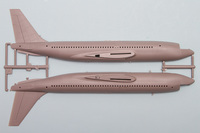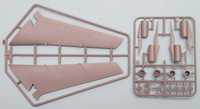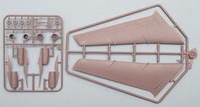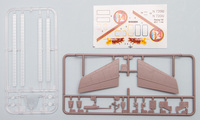Overview
The Boeing 720 was a derivative of their classic 707 airliner. Developed as a shorter range, lighter airliner that was capable of flying from shorter runways, the 720 was quick to enter service, with the first aircraft joining the United fleet in 1960. That first aircraft, N7201U, was later sold to Contemporary Entertainment, who created The Starship, an aircraft designed for touring bands. Led Zeppelin was the primary operator, although Alice Cooper, the Allman Brothers, Deep Purple, Elton John, Olivia Newton-John, and Peter Frampton also used it on their tours.
Due to issues with the aircraft in 1977, Led Zeppelin leased a different Boeing 720, N7224U, known as Caesar's Chariot. Originally operated by Caesar's Palace casino, Led Zeppelin added their titles and emblem to the aircraft for their 1977 tour. In 1979, the Bee Gees also used the aircraft for their tour, returning the aircraft to Caesar's Palace at the end of the year. In 1986, N7224U was purchased by Boeing Military Airplane Company for use in the KC-135 re-engine and spares support program.
The Kit
 Roden continues to expand their 1/144 airliner series, and seeing them come out with the Boeing 720 was quite exciting. Now that the kit is here, I can say that it is easily the best injection-molded 1/144 Boeing 720 currently available. Easy to say, because it is the only one in this scale, but even still, this is a nice kit. Recessed panel lines throughout, the kit comes with clear cockpit and cabin windows, detailed engines, and a small decal sheet for the Led Zeppelin Caesar's Chariot.
Roden continues to expand their 1/144 airliner series, and seeing them come out with the Boeing 720 was quite exciting. Now that the kit is here, I can say that it is easily the best injection-molded 1/144 Boeing 720 currently available. Easy to say, because it is the only one in this scale, but even still, this is a nice kit. Recessed panel lines throughout, the kit comes with clear cockpit and cabin windows, detailed engines, and a small decal sheet for the Led Zeppelin Caesar's Chariot.
The instructions begin with the assembly of the Pratt & Whitney engines. These are made up of two nacelle halves that also incorporate the pylon, with the intake and exhaust sections separate. The intakes are nicely done, but the exhausts will probably benefit from some extra little drill work to deepen the holes and thin the edges. A quick test fit shows that there is minimal difference between the one-piece intake and exhaust pieces and the two-piece nacelle, so with some careful sanding these could go together without any filler needed.
 Next up are the landing gear assemblies. The main gear struts are quite solid looking, with all four tires separate. There are petite strut scissors molded in place, while the large retraction arm is separate. The gear doors are also well done, with the main outer door done as a single piece that you have to fold up into shape. The nose gear is also well done, with separate wheels and a separate nose gear bay.
Next up are the landing gear assemblies. The main gear struts are quite solid looking, with all four tires separate. There are petite strut scissors molded in place, while the large retraction arm is separate. The gear doors are also well done, with the main outer door done as a single piece that you have to fold up into shape. The nose gear is also well done, with separate wheels and a separate nose gear bay.
At this point, the instructions have you build the wing subassemblies. The wings accurately capture the leading edge glove that was a distinguishing feature of the 720. The engine nacelles look to have a fairly sturdy attachment location, and again with some care one will not need any filler here. Once the wings are together, they can be added to the fuselage. The one-piece stabilizers also get attached at this stage.
 Speaking of which, the fuselage is next, and this is split into right and left halves, like we'd expect. There is some flash on the fuselage halves, most notably in the window openings, but a bit of work with a knife blade will clear this up fast. The cabin windows are provided as a strip to insert from the inside, while the cockpit window is done as one piece that incorporates the upper fuselage section as well. Also for the inside of the fuselage halves are two blanking pieces for the main gear well. The instructions indicate that you'll need to add about 10 grams of weight in the nose, and with that, you're ready to paint.
Speaking of which, the fuselage is next, and this is split into right and left halves, like we'd expect. There is some flash on the fuselage halves, most notably in the window openings, but a bit of work with a knife blade will clear this up fast. The cabin windows are provided as a strip to insert from the inside, while the cockpit window is done as one piece that incorporates the upper fuselage section as well. Also for the inside of the fuselage halves are two blanking pieces for the main gear well. The instructions indicate that you'll need to add about 10 grams of weight in the nose, and with that, you're ready to paint.
 For the decal scheme, there's some good news and some bad news. The good news is that the decals are very nicely printed and do an excellent job of capturing the chariot, Led Zeppelin titles, and the tail logo. The bad news is that you will have to paint the fading stripes, both the large pale blue to dark blue and the smaller light yellow to brown. The blue is a bit simpler, as you can start with one shade and fade it to another, with no real matching to worry about. The yellow to brown, though, will need to end up matching the brown stripe decal on the tail, plus it's trimmed in yellow, so that's going to be a big challenge there.
For the decal scheme, there's some good news and some bad news. The good news is that the decals are very nicely printed and do an excellent job of capturing the chariot, Led Zeppelin titles, and the tail logo. The bad news is that you will have to paint the fading stripes, both the large pale blue to dark blue and the smaller light yellow to brown. The blue is a bit simpler, as you can start with one shade and fade it to another, with no real matching to worry about. The yellow to brown, though, will need to end up matching the brown stripe decal on the tail, plus it's trimmed in yellow, so that's going to be a big challenge there.
Further adding to the finishing challenges, the decal sheet provides the N7201U registration in black on the rear fuselage. While the registration is indeed in black, Caesar's Chariot was N7224U. What is rather hilarious in a sad sort of way is that Roden knew this, as the painting instructions label the aircraft as "Boeing 720 N7224U 'Caesar's Chariot', Led Zeppelin North American Tour, Summer 1977." Of course, N7201U was Led Zeppelin's original Boeing 720, so it's easy to see where the confusion came from. Since it is in black, it will be just a slight hiccup in finishing, as one could easily print this on a laser printer or scrounge numbers from the spares box.
Conclusion
This is a great airliner kit from Roden, and despite the challenging paint scheme, it will be a fun one to build. I'm looking forward to trying some ideas out on those fading fuselage stripes. My thanks to Squadron for the review sample.